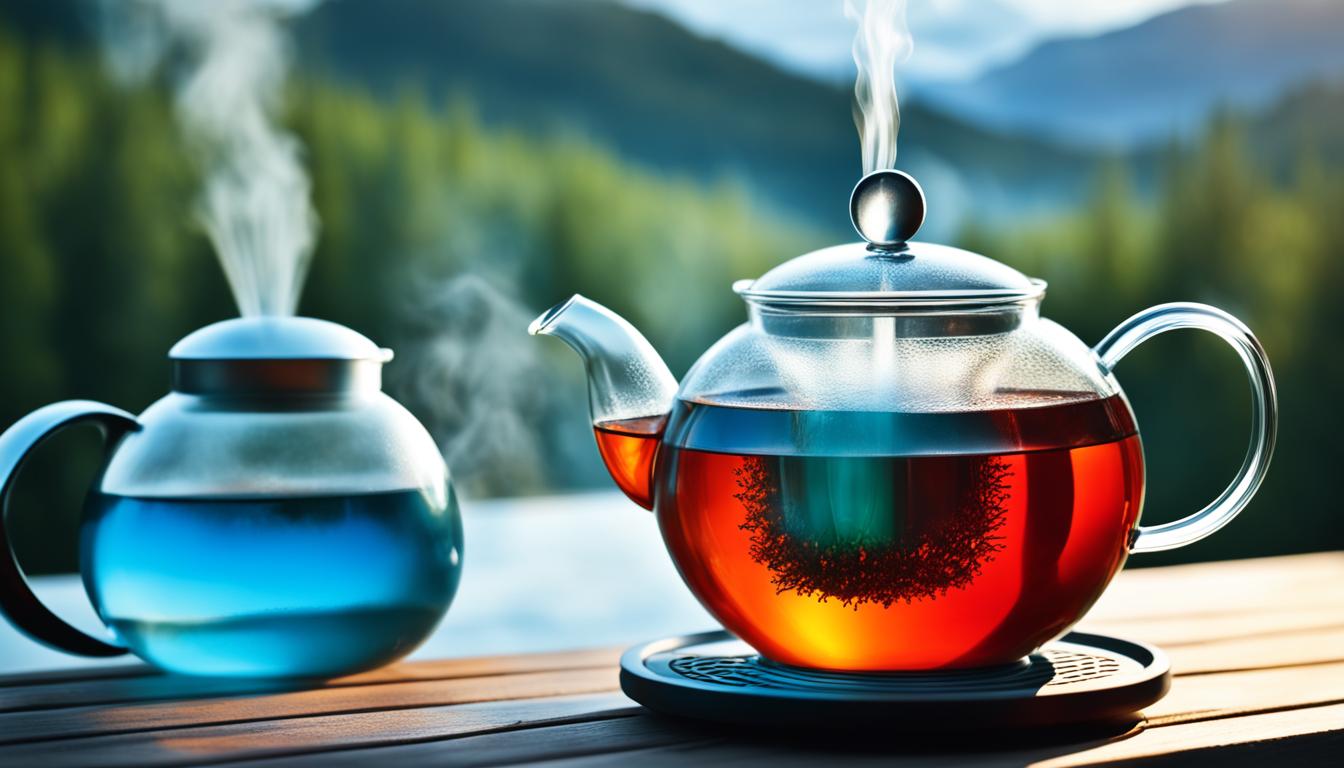Water temperature is a crucial factor in tea brewing science. The optimal water temperature for brewing tea significantly influences the flavor and aroma of the final cup. Different types of tea require specific temperature ranges to bring out their best characteristics. For example, delicate green teas often require lower temperatures (around 70-80°C or 158-176°F) to prevent bitterness, while robust black teas can handle higher temperatures (around 90-100°C or 194-212°F) to fully extract their flavors. Understanding and controlling water temperature is essential in tea steeping guides and tea brewing best practices, ensuring that each type of tea is brewed to perfection, highlighting its unique qualities.
Are you a tea lover or a newcomer eager to learn? Mastering water temperature is crucial. It’s about the science behind every brew, making sure every sip reflects the tea’s essence.
Key Takeaways
- Understanding the science behind tea steeping temperatures.
- Applying correct temperatures for different tea varieties as outlined in tea steeping guides.
- Incorporating optimal water temperature into your brewing routine.
- Adhering to tea brewing best practices for taste and health benefits.
- Exploring the tea brewing science for an enhanced brewing experience.
The Ravages and Rewards of Temperature on Tea Polyphenols
The importance of water temperature in tea making is very important. It’s key to getting the most out of tea polyphenols. These are not just for flavor. They’re also the antioxidants in tea that bring lots of health benefits. So, the right tea brewing temperatures matter a lot. They make sure these polyphenols are extracted well or stay unchanged.
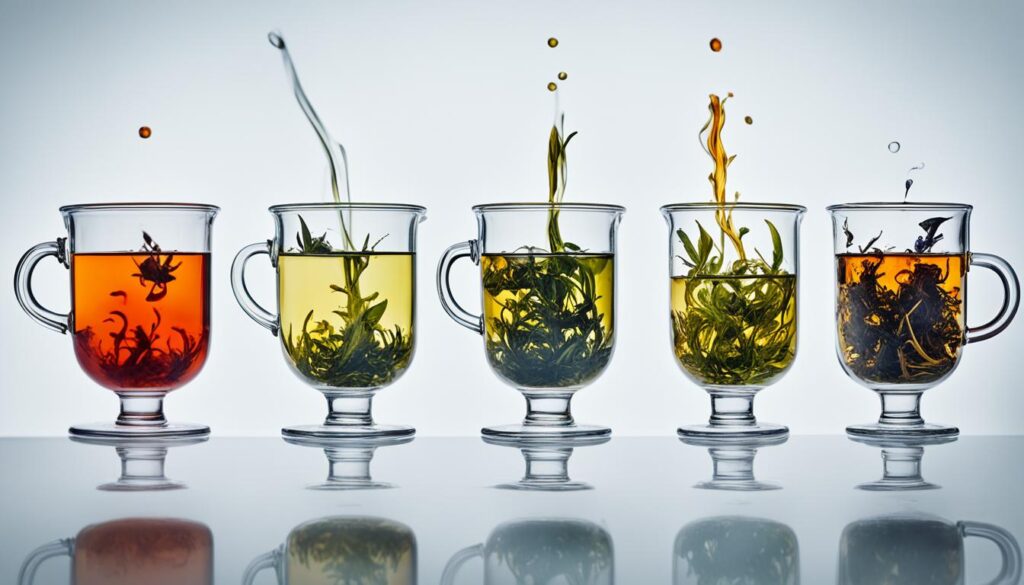
Tea polyphenols act as the plant’s defenders against harm like UV rays and germs. The water’s temperature changes their strength and how effective they are. Depending on how hot or cool you brew your tea, you can either boost or lessen these antioxidants’ health benefits.
- Lower temperatures preserve delicate polyphenol structures, enhancing the subtle flavors and health benefits.
- Higher temperatures can expedite oxidation, potentially leading to a more robust flavor but also a risk of destroying sensitive compounds.
It’s important to understand how water temperature and tea polyphenols work together. This knowledge helps you enjoy the tea’s full flavor and its health benefits. It’s not just about making tea. It’s also about keeping the leaf’s powerful qualities.
“Just as a master chef wields heat to coax flavors from ingredients, the tea brewer manipulates water temperature to draw forth the vitality of the leaf, manifesting in a harmonious blend of taste and health.”
Making the perfect cup of tea is about finding the right balance. It combines heat’s energy with the leaf’s biochemistry. This balance honors an old tradition and modern health knowledge. By controlling the brewing temperature, you unlock all the flavors and health benefits of the tea. This shows deep respect for a craft rooted in both culture and science.
The Science of Water Temperature for Tea
Exploring the Science of Water Temperature for Tea shows its big role in tea’s taste and health perks. Knowing how to brew tea right makes our drinking experience and health better.
Understanding Water Temperature’s Impact on Tea Aroma and Digestives
Brewing tea is not just about the temperature. It’s a key to unlocking amazing flavors and aromas. The right temperature changes with the tea type. For instance, green tea needs cooler water. This avoids too much bitterness.
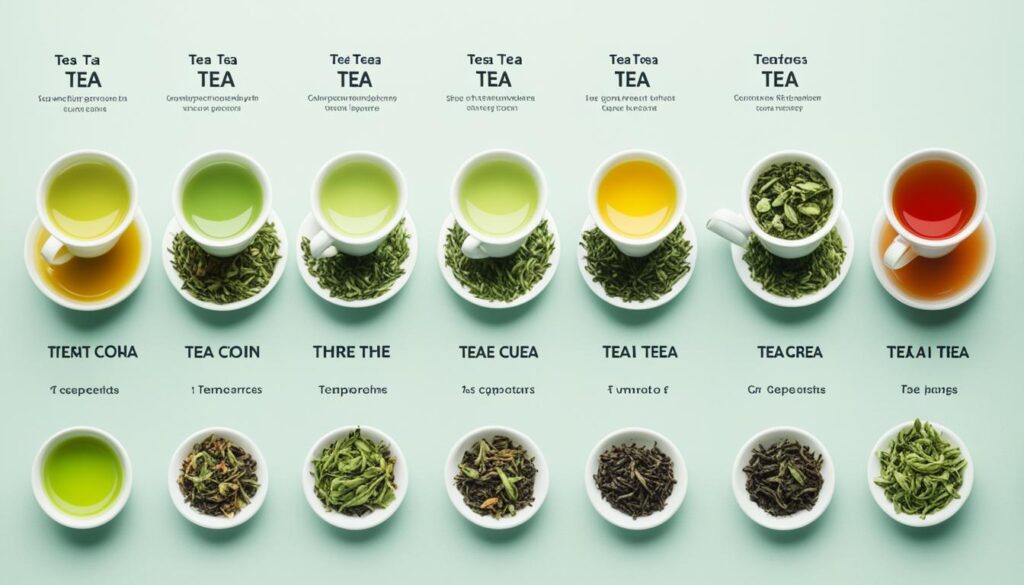
Heat Control Techniques for Different Tea Types
Tea experts use special tools to control the water’s heat. Clay pots are great for oolong and black teas because they keep heat well. Glass pots are best for green and white teas, which need cooler water. This blend of time, temperature, and the right pot makes the perfect tea.
Scientific Studies on Polyphenols and Health Benefits
Tea is more than a drink; it’s full of health benefits from polyphenols. Brewing it right, by following temperature guidelines, helps get these benefits. These include protecting from the sun and boosting immunity. Every cup of properly made tea is both tasty and a step towards better health.
Tea Brewing Temperatures and Their Effects on Flavor
The importance of water temperature in tea flavor is huge. It’s key to making great tea. Knowing the best temperatures for brewing brings out the most flavor. Let’s talk about how temperature changes the taste of green, black, and oolong teas.
Green tea likes cooler water. This means water between 160°F and 180°F. Cooler water stops it from getting bitter. This gives a balanced, smooth drink with sweet and fresh tastes.
Black tea needs hotter water. This unlocks its strong taste. Water between 195°F and 205°F makes it bold and aromatic, but not bitter. High temperatures pull out deep, complex flavors that black tea lovers value.
Oolong tea sits in the middle for temperature needs. It likes water between 185°F to 205°F. This balance lets oolong’s floral and toasted flavors shine. It shows off oolong’s elegance in your cup.
Whether it’s the green tea’s freshness or black tea’s depth, water temperature brings out the best in your cup.
Getting the water temperature right is crucial for enjoying tea. Here are temperatures for a perfect brew:
- Green Tea: 160°F – 180°F
- Black Tea: 195°F – 205°F
- Oolong Tea: 185°F – 205°F
Not using these temperatures can ruin your tea. It can make flavors too weak or too strong. Mastering water temperature lets tea’s true taste come through.
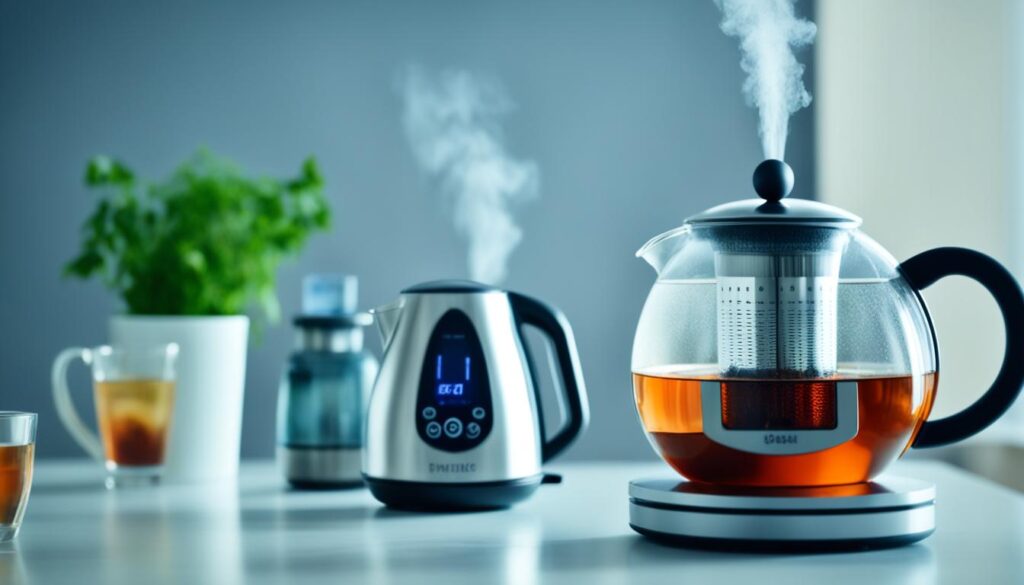
With this info, tea lovers can get better at making tea. Following these tips is a start. But tweaking the temperature for your taste makes your tea even better.
Best Practices for Brewing Various Types of Tea
Tea lovers know the right water temperature is key for tea brewing. It can change the quality of your tea. Mastering tea brewing temperatures combines science with art. This leads to a delightful cup of tea. Different teas need different heat levels, so it’s crucial to match the brewing practice to the tea type.
Crafting Perfect Black Tea: High Heat for Richness and Complexity
If you’re making black tea, a higher temperature is best. Aim for 195°F to 205°F to bring out its full taste and complexity. Brewing it right means avoiding a tea that’s too bitter or weak. This results in a strong, tasty cup.
Green and White Teas: Sensitive Leaves Need Gentle Warmth
Green and white teas need a softer touch, with temperatures from 160°F to 180°F. Keeping the right temperature is vital to keep their delicate flavors. This way, you avoid bitterness and get a light, refreshing tea.
Oolong’s Unique Needs: Balancing Between Extremes
Oolong tea works best with water temperatures between 185°F and 205°F. This range suits the varied oxidation levels of oolong, developing its unique aroma. Getting the temperature right is critical for the best flavor in oolong tea.
| Tea Type | Optimal Brewing Temperature | Steeping Time |
|---|---|---|
| Black Tea | 195°F – 205°F | 3-5 minutes |
| Green Tea | 160°F – 180°F | 2-3 minutes |
| White Tea | 160°F – 180°F | 4-5 minutes |
| Oolong Tea | 185°F – 205°F | 4-7 minutes |
Using this tea steeping guide will help both experts and beginners make great tea. The key is to honor each tea’s unique nature and follow precise brewing methods. By doing this, you get to enjoy a cup of tea that truly reflects its essence.
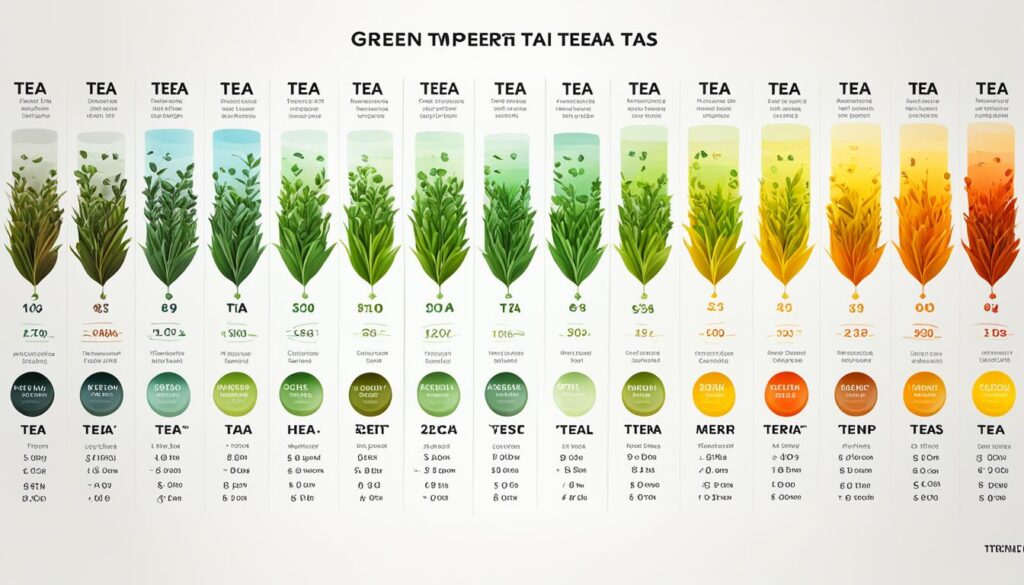
Conclusion
To truly master the art of tea brewing, blending tradition with science is key. The right water temperature is crucial. It unlocks the unique flavors of each tea type.
For any tea lover, understanding the science of water temperature is vital. It lets you fine-tune your brewing. This way, you can enjoy a range of tastes and smells that suit your taste.
But, it’s not just about the perfect cup. It’s about how tea brewing fits into our lives. It’s a balance of beauty, health benefits, and deep-rooted traditions. In short, it’s an art that enhances our well-being in many ways.

